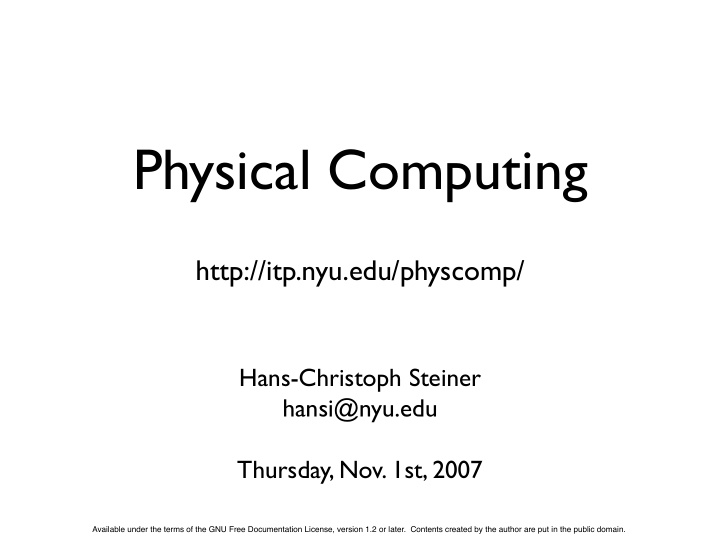



Physical Computing http://itp.nyu.edu/physcomp/ Hans-Christoph Steiner hansi@nyu.edu Thursday, Nov. 1st, 2007 Available under the terms of the GNU Free Documentation License, version 1.2 or later. Contents created by the author are put in the public domain.
Questions?
motion is constructed http://itp.nyu.edu/~hs420/constructedmotion.png
movement http://www.cogsci.uci.edu/%7Eddhoff/phi2.gif
grouping http://www.cogsci.uci.edu/personnel/hoffman/ternus-group.gif
something in the woods... http://www.cogsci.uci.edu/personnel/hoffman/COLORDISK.gif
grouping into shapes http://www.cogsci.uci.edu/personnel/hoffman/sfm.gif
phantom limbs Radio Lab: Where Am I? http://www.wnyc.org/shows/radiolab/episodes/2006/05/05
phantom limbs Radio Lab: Where Am I? http://www.wnyc.org/shows/radiolab/episodes/2006/05/05
learning from strokes • facial perception • perception of motion • proprioception • many other examples
continuum of cognitive load sensory → perceptual → cognitive → symbolic → linguistic → semantic • sensory: color, loudness, touch • perceptual: motion, loudness, inertia • cognitive: presence, a voice • symbolic: letter, icon, earcon, braille • linguistic: words, intonation of words, music • semantic: sentences, phrases • (thanks to Brad Paley)
serial communication 0010010101001101 00010101 01010010 10100101010101001 001001010100110 10001010 10101001 010100101010101001 http://commons.wikimedia.org/wiki/Image:Arduino_nobg.png http://commons.wikimedia.org/wiki/Image:Laptop_icon.svg
Arduino XBee http://www.sparkfun.com/commerce/images/ArduinaXbee-02-L.jpg
Arduino Bluetooth http://www.sparkfun.com/commerce/images/Arduino-BT-01-L.jpg
MIDI Musical Instrument Digital Interface • note on/noteoff • note numbers (0-127) • velocity, pitch bend, aftertouch • byte-based (0-255) serial at 31250 baud • data: 0-127 commands: 128-255 • two byte and three byte messages
Firmata • Pd, Processing, Max/MSP , Flash, python, vvvv • use Arduino in the language of the host • standard protocol to support many languages
final project http://itp.nyu.edu/physcomp/Intro/FinalProject • the same idea as the midterm project • you can work alone or in groups of up to three • document each step as you go • make sketches, prototypes, user tests, etc. • emphasis on clear interaction and sensing actions • should generate timely and appropriate responses • present progress in alternating classes until the end
assignment for next week • present your observations for final project • no lab • no reading • keep writing in your journals, document your work
Recommend
More recommend